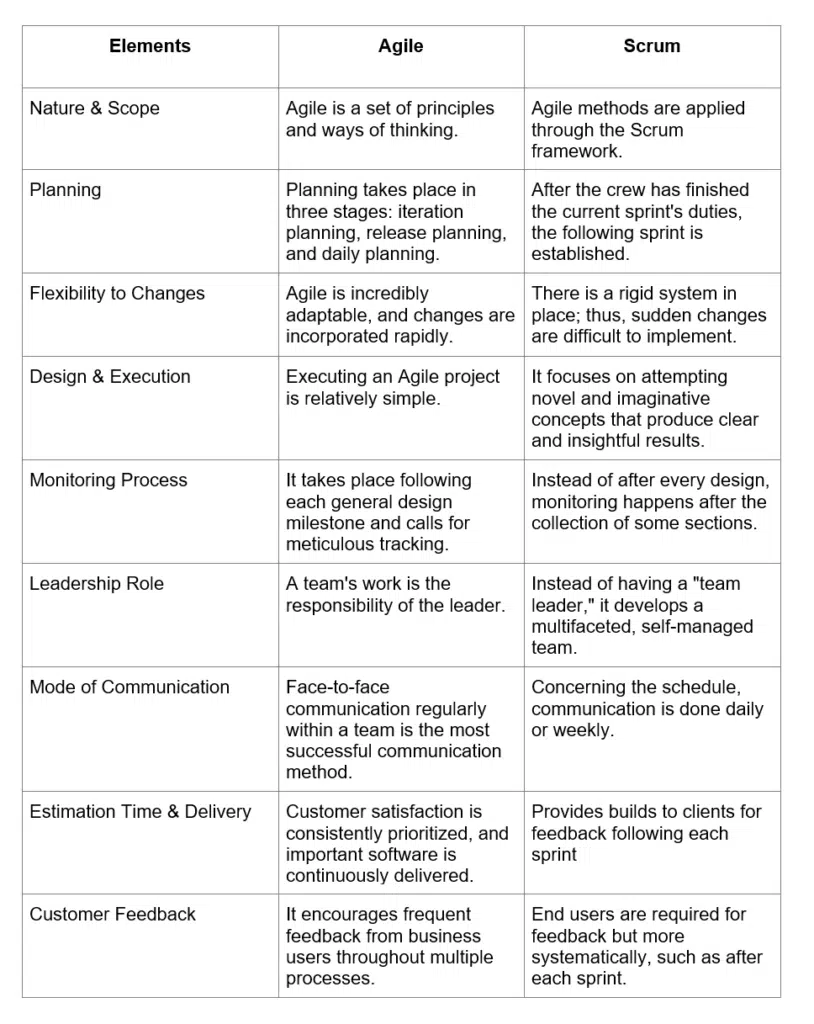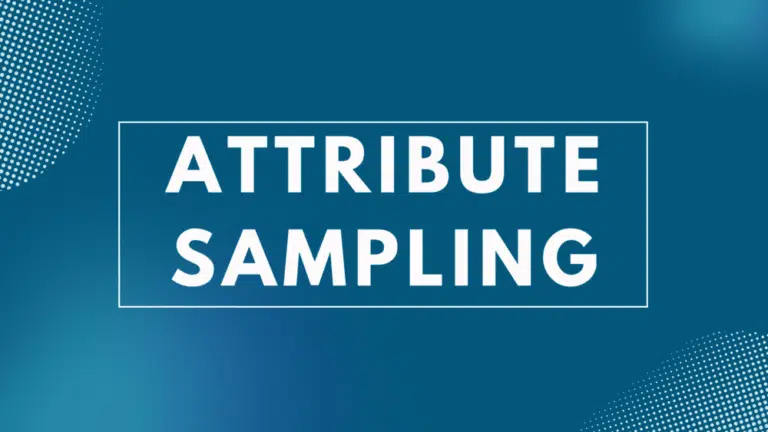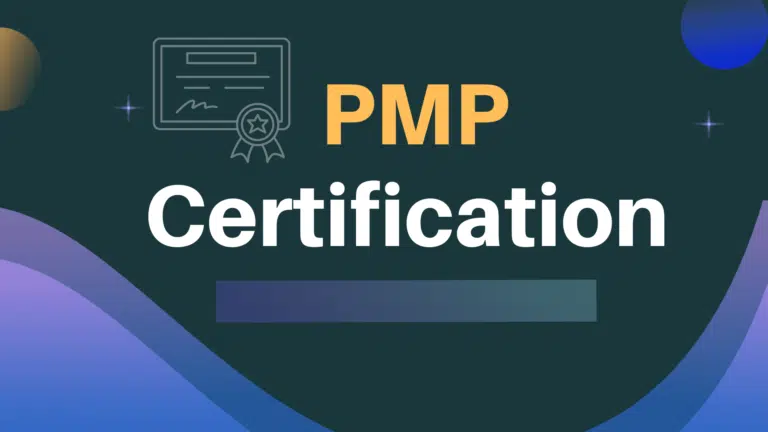The vast majority of people in the project management industry use the terms “Scrum” and “Agile” interchangeably, though they are different.
The agile methodology is a collection of frameworks that emphasizes on completing projects in incremental steps. This methodology is used for projects that are unpredictable and volatile. Scrum, on the other hand, is just one of many different agile frameworks.
Let’s see the difference between Scrum and Agile.
The History of Agile
In the spring of 2000, 17 software developers and individuals, including Martin Fowler, Jim Highsmith, Jon Kern, Jeff Sutherland, Ken Schwaber, and Bob Martin, met in Oregon to debate speeding up development and quickly launching the software to market.
Less than a year after the meeting, these developers gathered again in the Wasatch Mountains of Utah one frigid February to plan a list of principles with the belief that it would help a healthier organizational culture. The outcome was the Agile Manifesto, which included four Agile ideals and twelve Agile principles.
What is Agile?
Agile is a methodology for project management that aims to accomplish a goal by completing it in a series of incremental steps. A single launch is not part of an Agile project; rather, the project is broken up into smaller chunks of updates to the product, each of which can be delivered in a shorter amount of time.
This enables project teams to adapt to shifting priorities and respond to changes, requirements, and problems as they arise during the course of the project. It results in a reduction in expenses, time, and labor.
It is necessary for organizations to utilize a framework in order to adopt Agile practices. The most widely used Agile framework is called Scrum.
The agile project management methodology is based on four values:
- Staying true to a strategy in the face of change.
- Client involvement in contract negotiations.
- Comprehensive paperwork is preferred over software.
- Individuals and connections come before techniques and systems.
The development of products is done in an iterative manner when using the Agile methodology.
The Project Management Institute (PMI) states that the objective of the Agile methodology is to provide an early and measurable return on investment (ROI) through the iterative delivery of product features.
Because Agile techniques are iterative, regular client participation is necessary to ensure their expectations are met and allow the project manager to adjust changes throughout the process.
When Should You Use Agile?
Agile is suited where key elements are unclear from the start. Agile is ideal for organizations dealing with unpredictable changes in product development or developing new products. Traditional project management approaches, such as waterfall, are useful for projects with a fixed scope of work.
How to Implement Agile in Your Organization
Once a project manager decides to use Agile methodology for their project, they can use the following steps to implement Agile frameworks in their processes.
Obtain Stakeholders’ Approval
Agile values cooperation among team members, customers, and other key stakeholders, such as the project sponsor and vendors. To implement Agile, you must get all stakeholders on board. Speak with stakeholders, explain the benefits of using the Agile framework, answer their questions, and address reservations.
Begin With A Single Project
Incremental and iterative advancement are key agile approaches. Start with a small project, show management results, and answer their questions. If it is successful, you may use Agile methodologies on other projects.
Motivate Team Members
Team members are required to interact with one another and work together in Agile methodologies. An agile strategy will fail if the project team is not engaged and motivated. The idea that projects should be built around motivated employees and that those employees should be given the support and trust necessary to complete the work is a central tenet of the Agile methodology.
Choose And Stick To A Framework
Agile causes changes in the way the project team does things. It is critical to choose and adhere to an Agile framework.
For example, if you are using Scrum, you should hold daily Scrum meetings – no matter how busy everyone claims to be.
Do not jump to different Agile frameworks.
Review And Revise
It is necessary to adhere to a tried-and-true procedure for an Agile framework when putting the method into action for the first time.
When the team is still in the process of learning the procedures, you must not begin experimenting with hybrid frameworks or changing the rules in the middle of a sprint.
An essential part of the Agile methodology is the retrospective, which identifies what is working and what is not. After that, you can make adjustments and corrective and preventative measures. After each sprint and the completion of the project, it is essential to get the team together to talk about the next steps.
What are the Benefits of Agile?
Superior Value For The Finished Product
Testing is considered an integral part of the Agile development methodology, which ensures that the final product will have a high level of quality. The client is included in the development process and can make adjustments based on how the market is shifting. Teams that organize themselves receive feedback on an ongoing basis and continue to develop the product over the course of time because the process is iterative and continues to get better.
Customer Satisfaction
Unlike in the traditional setup, the client is involved in the decision-making process, which translates into higher customer retention. Client satisfaction is maximized by keeping them in the loop and implementing adjustments based on their feedback.
Improved Command
Agile gives project managers more control over projects because of its openness, feedback integration, and quality-control features. Client involvement ensures quality throughout the product development, and stakeholders are updated via status reports.
Improved Project Predictability
When there is more visibility, predicting possible risks and developing strategies that effectively mitigate risks is much simpler. The Agile framework includes many different strategies, both for identifying risks and for making the necessary preparations to ensure that the project will be successful.
For instance, Scrum uses burn-down charts and sprint backlogs to boost project awareness, enabling project managers to anticipate efficiency and plan ahead.
Reduced Risks
In principle, every project following the Agile process will never fail. Agile is implemented in tiny sprints with an emphasis on continuous delivery. If a technique does not work, record details for future review.
Enhanced Adaptability
When Agile is used correctly, it gives them unprecedented flexibility. Teams operate in shorter spurts, complemented by the product owner’s continual input and engagement.
Changes in other project management approaches are time-consuming and costly.
Agile divides the project into smaller sprints that are controllable and flexible enough to allow the team members to adapt to changes. One of the primary reasons organizations use Agile in their projects is its unparalleled functionality.
Constant Improvement
One of the 12 fundamental principles outlined in the Agile Manifesto is to actively engage in self-reflection and strive toward continuous improvement. Because the processes are iterative, the subsequent sprint will be more successful than the one before it, and none of the errors from the previous sprint will be repeated.
Agile methodologies promote a cooperative and open environment to exchange ideas; this enables team members to gain knowledge from one another and build upon their prior experiences.
Increased Team Spirit
Because Agile teams are self-organized and self-managing, they have increased independence and control over their judgments. The project manager safeguards the team against sponsorship and managerial influence.
The cross-functional nature of the teams helps members learn new skills. The team frequently meets to discuss challenges and difficulties, which allows them to interact more effectively. Agile encourages a close-knit environment where teams can have flexible combinations because team sizes are narrow.
What is Scrum?
Scrum is a project management framework that prioritizes collaboration, responsibility, and incremental advancement toward an objective. The concept begins with a simple instruction: Start with what is obvious or comprehensible. Following that, the results should be evaluated, and any necessary adjustments should be made.
Within the framework of Scrum, delivery cycles are referred to as “sprints” and can last anywhere from one to four weeks. The work is completed bit by bit, building on previous efforts as it goes. Scrum teams are not very large; typically, they consist of fewer than nine people and are led by a product owner and a Scrum master. Maintaining open lines of communication with team members and other stakeholders enables the group to more easily collect ongoing feedback and make adjustments as necessary.
Scrum is supported by three pillars:
- All participants have full access to information, including progress and goals.
- Changes in priorities may cause changes to the project and the work.
- Evaluation: The team is always looking for ways to make the product and the processes better.
It is supported by five values.
- Courage
- Respect
- Focus
- Openness
- Commitment
The project is managed by a cross-functional team consisting of the project manager, the Scrum Master, and the Product Owner. While the Scrum Master ensures that the project team adheres to the Scrum framework, the product owner is in charge of increasing the product’s value.
The Scrum methodology is distinguished by short time frames known as “sprints,” during which the work that has been planned is finished. During the planning phase of a sprint, the project team members select a manageable portion of the overall scope to focus on completing during the subsequent sprint, which can last anywhere from two to four weeks.
At the end of the sprint, the client receives the finished deliverable that was worked on during the sprint. This makes it easier for the customer to see the value of the project as it is being developed, as opposed to having to wait until it is finished. The completion of the sprint is marked by a sprint review and retrospective, also known as lessons learned. The process is carried out repeatedly until an entirely finished product is obtained.
When Should You Use Scrum?
Scrum is ideal for managing complex projects in a dynamic environment. Like many Agile frameworks, Scrum is ideal for organizations with continuous changes in the environment or launching new initiatives. A conventional method can be useful if the organization does not allow seamless cross-functional communication.
Agile Vs Scrum
Scrum is a framework for agile development. Scrum is a good choice when quick results are required because it follows strict processes and leaves less room for adjustment than other methodologies. Scrum is better suited to innovative and experimental approaches, whereas Agile is better suited to smaller teams and individuals who want a more clear design and execution.
The below table shows the difference between Agile and Scrum.

How do Agile and Scrum Work Together?
In order to reap the benefits of both methodologies, project managers frequently combine the two frameworks. The combination of these two methodologies produces the Agile Scrum approach. The Agile Scrum method is a technique that is formed by combining the Agile ideology with the Scrum framework. Agile is an acronym that stands for “incremental,” and it instructs teams to break down their projects into more manageable components.
Scrum is one of the many frameworks that comprise the Agile framework. Scrum is well-known for its ability to divide projects into sizeable units called “sprints.” Agile Scrum is a methodology that can be helpful for companies that have an urgent need to complete certain projects.
The principle of incremental progress underpins the Agile Scrum approach to project management, which utilizes the Scrum framework. Each iteration is comprised of one or more sprints, each of which lasts between two and four weeks.
The objectives of a sprint are to develop a product that is marketable and to first construct the essential features of the product. During subsequent iterations of the sprint, the scope of the product is increased, and modifications are implemented in response to comments made by stakeholders and customers.
The combination of Agile development and Scrum has many desirable effects. To begin, the fact that every group of objectives has to be finished within the allotted time for each sprint makes for quicker product development. Additionally, it results in continuously setting goals and scheduling activities, which enables the Scrum team to concentrate on the objectives of the current sprint and increase output.
Conclusion
Scrum is just one of the many frameworks that are included in Agile; it has its own distinct set of characteristics. It is necessary for you to conduct an analysis of the requirements of your project in order to determine which Agile methodologies are most appropriate for your endeavor. Agile frameworks are not useful when it comes to projects with clearly defined requirements. Scrum works best for projects that do not have clearly defined goals, are flexible enough to accommodate those goals, and/or call for testing at regular intervals.

I am Mohammad Fahad Usmani, B.E. PMP, PMI-RMP. I have been blogging on project management topics since 2011. To date, thousands of professionals have passed the PMP exam using my resources.







